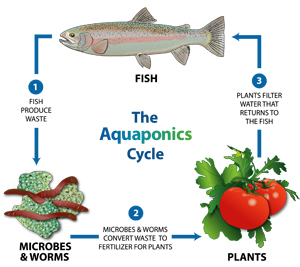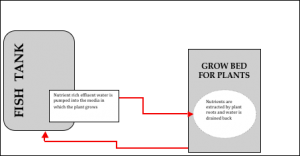What's Your Reaction?
Aquaponics is basically an innovative and a modern approach to food production that combines the best of natural principles of hydroponics and aquaculture. By engineering the cultivation of fish as wellplants in a systematic, soilless system, the process of Aquaponics uses natural mechanisms, resulting in the production of safe, organic fish and food products all around the year.
How does it work?
The key logic that explains this mode of food production is the fact that it uses the nutrient rich fish affluent to fuel the growth needs of the plants. Let’s take a closer look at how is this achieved.
To begin with, huge quantities of fish are usually stocked in tanks. On the other hand, plants are bred in grow beds, which are filled with a medium. This base or medium can be made of a vast range of materials such as gravel, riverstone, crushed basalt, expanded clay and the like.
Now, the fish tanks which have been stocked earlier, get filled with polluted, but effluent-rich water over time. Since this water is full of nutrients required for plant growth, it is pumped through the grow bed we mentioned earlier. Once done, the plant roots extract the nutrients from the water, draining right through the gravel or whatever the medium of the plant bed is.
Here, it is the beneficial bacteria that play an important role. It is this bacteria that break down the elements in the water into a usable form which the plants can easily absorb as nutrition.
Finally, this water is pumped back into the fish tank, where it again gets polluted with effluents after some time and the process goes on. Just take a look at the image below which explains this process.
AQUAPONICS – THE PROCESS
Aquaponics – The 2-Edge Benefit The novel concept of Aquaponics offers a unique 2-edge benefit to the entire system of food production, the first one being minimum water consumption as compared to the conventional system of hydroponics. In a typical hydroponics set-up, the water ideally needs to be discharged after every short while as it becomes toxic due to the salts and chemical build-up. However, in Aquaponics, this effluent-rich water is recycled after the nutrition has been extracted by the plant roots, after which it is reverted back to the fish tank.
Secondly, since the entire procedure is manmade and chemically engineered, it can facilitate production of organic fish and certain food products all around the year, of a better standard and a higher quality. The fact that no synthetic fertilizers can be added since they can destroy the beneficial bacteria makes the entire model of production totally organic in nature.
In other words, Aquaponics system uses the forces of nature to its best. All the ingredients involved in food production including the fish, plants and even the water stay in their most natural form, without any synthetic supplements or additives. This ensures that you have access to the most natural form of a food produce. Minimum consumption of water for breeding fish as well as plants is another added advantage.
Fish to use
Since fish form the backbone of an Aquaponics system, the type of fish you choose will determine how successful your venture is. Here, we’ve furnished a quick list of some of the most beneficial Aquaponics species of fish, the ones that you can use in this mode of farming. Just make sure you know your priorities first. For instance you need to choose an edible fish of you want eat the meal too. Some of the most common species you could consider are:
- Catfish
- Barramundi
- Jade Perch
- Goldfish
- Carp
- Murray Cod
- Koi
- Tilapia
- Trout
- Silver Perch
Hydroponics is another great way to grow your own food. We will publish an article about it next week.
Conclusion
Aquaponics is a novel method of food production that facilitates the breeding of plants and fish in the same environment. Apart from saving on natural resources such as water and energy, Aquaponics also leads to the production of high quality organic fish and food products, all around the year. The process can be carried out commercially as well as at your own home using old discarded equipment. You can even purchase the useful do-it-yourself kits for Aquaponics easily available off-the-shelf.
References
Source: http://goo.gl/mGEFg


Aucun commentaire:
Enregistrer un commentaire